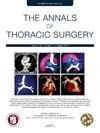癌症委员会关于肺切除术后淋巴结取样和肿瘤结果的标准。
IF 3.6
2区 医学
Q1 CARDIAC & CARDIOVASCULAR SYSTEMS
引用次数: 0
摘要
背景:癌症委员会(CoC)的最新标准建议在肺癌切除术中取样 3 个纵隔淋巴结站和 1 个肺门淋巴结站,即 3(N2)1(N1)。然而,CoC 标准与结果之间的关系尚未得到深入研究:方法:对新标准实施前临床 I-III 期肺癌切除术的前瞻性机构数据库进行了查询。采用多变量模型评估了3(N2)1(N1)标准("指南一致")与预后(上行分期、并发症、接受辅助治疗、局部/远处复发和生存)之间的关系,并按分期进行了分层:在9289例肺切除术中,3048例(33%)符合指南要求,6241例(67%)不符合。与不符合指南者相比,符合指南者的结节上移率更高(21% vs 13%;OR 1.32 [95% CI 1.14-1.51] p结论:3(N2)1(N1)取样与临床I期或II期患者的上行分期和并发症增加有关,但与复发率或死亡率降低无关。临床 III 期患者的生存率有所提高。为确定不同类型肺癌患者的理想淋巴结取样策略,还需要进一步研究。本文章由计算机程序翻译,如有差异,请以英文原文为准。
Commission on Cancer Standards for Lymph Node Sampling and Oncologic Outcomes After Lung Resection
Background
The newest Commission on Cancer standards recommend sampling 3 mediastinal and 1 hilar lymph node stations, 3 (N2) 1 (N1), for lung cancer resections. However, the relationship between the Commission on Cancer standards and outcomes has not been thoroughly investigated.
Methods
A prospective institutional database was queried for clinical stage I-III lung resections before the implementation of the new standards. The relationship between the 3 (N2) 1 (N1) standard (“guideline concordant”) and outcomes (upstaging, complications, receipt of adjuvant therapy, locoregional/distant recurrence, and survival) was assessed with multivariable models and stratified by stage.
Results
Of 9289 pulmonary resections, 3048 (33%) were guideline concordant and 6241 (67%) were not. Compared with nonconcordant, those that were guideline concordant had higher rates of nodal upstaging (21% vs 13%; odds ratio [OR], 1.32 [95% CI, 1.14-1.51]; P < .001) and in-hospital complications (34% vs 27%; OR, 1.17 [95% CI, 1.05-1.30]; P = .004) but similar adjuvant systemic therapy administration (19% vs 13%; OR, 1.09 [95% CI, 0.95-1.24]; P = .2; 98% chemotherapy). Locoregional and distant recurrences were not significantly improved with guideline concordance across clinical stage I, II, and III subsets. Overall survival was similar in clinical stages I and II, but improved survival was observed for guideline concordant clinical stage III patients (hazard ratio, 0.85 [95% CI, 0.74-0.97]; P = .02).
Conclusions
Sampling 3 (N2) 1 (N1) was associated with increased upstaging and complications but not with decreased recurrence or mortality in clinical stage I or II patients. Survival was improved for concordant, clinical stage III patients. Further study is indicated to determine the ideal lymph node sampling strategy across heterogeneous lung cancer patients.
求助全文
通过发布文献求助,成功后即可免费获取论文全文。
去求助
来源期刊

Annals of Thoracic Surgery
医学-呼吸系统
CiteScore
6.40
自引率
13.00%
发文量
1235
审稿时长
42 days
期刊介绍:
The mission of The Annals of Thoracic Surgery is to promote scholarship in cardiothoracic surgery patient care, clinical practice, research, education, and policy. As the official journal of two of the largest American associations in its specialty, this leading monthly enjoys outstanding editorial leadership and maintains rigorous selection standards.
The Annals of Thoracic Surgery features:
• Full-length original articles on clinical advances, current surgical methods, and controversial topics and techniques
• New Technology articles
• Case reports
• "How-to-do-it" features
• Reviews of current literature
• Supplements on symposia
• Commentary pieces and correspondence
• CME
• Online-only case reports, "how-to-do-its", and images in cardiothoracic surgery.
An authoritative, clinically oriented, comprehensive resource, The Annals of Thoracic Surgery is committed to providing a place for all thoracic surgeons to relate experiences which will help improve patient care.
 求助内容:
求助内容: 应助结果提醒方式:
应助结果提醒方式:


